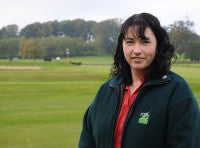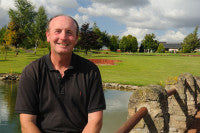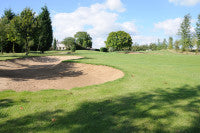Thatch attack!
 Disease attacks on the turf leaf cause visible damage and reduce playing surface quality. But, turf managers need to be looking deeper to identify and manage the source of the problem, writes STRI Head of Turfgrass Protection, Dr Ruth Mann.
Disease attacks on the turf leaf cause visible damage and reduce playing surface quality. But, turf managers need to be looking deeper to identify and manage the source of the problem, writes STRI Head of Turfgrass Protection, Dr Ruth Mann.
The problem is that the pathogens that cause turf disease, including Fusarium, Dollar Spot and Anthracnose, may survive in the thatch or rootzone as spores or dormant mycelia, waiting for the right conditions to return. In some cases, the pathogen will be growing and proliferating in the turf base or rootzone long before we see the symptoms of the disease on the surface.
Using Integrated Turf Management (ITM), to create an environment at the turf base that is unfavourable to the pathogen, will, therefore, reduce its ability to multiply so rapidly, and delay infection of the turf plants.
This can be done in many ways, including aeration to encourage beneficial aerobic fungi and bacteria in the rootzone, which 'fill' the spaces where pathogens would live. These beneficial organisms will also break down organic matter - which is often also the food source that disease pathogens survive on. Adjusting the fertiliser strategy or irrigation scheduling, for example, will also affect the turf environment.
Furthermore, fungicide application to the thatch has also been shown to reduce the inoculum of certain diseases. Work by Paul Koch, of the University of Wisconsin-Madison, demonstrated that applications of fungicide reduced the inoculum of Sclerotinia homoeocarpa and prolonged the period before Dollar Spot symptoms became unacceptable on turf. It was concluded that this early season fungicide use could reduce the following season-long fungicide programme by up to two applications - saving time and money.
Therefore, on courses with continual history of a certain disease, applying an appropriate fungicide early in the season - when we know the pathogen is multiplying, but before we see symptoms - may enhance the overall fungicide programme effectiveness and enhance turf quality.
Fludioxonil focus
Fludioxonil is a new contact fungicidal active ingredient from Syngenta - the first new contact for turf for over thirty years. But, unlike previous or current contacts which simply stick on the leaf surface to protect against disease pathogen attack, fludioxonil also works to tackle turf disease pathogens present on the leaf and in the thatch and soil.
This contact plus activity could prove an especially valuable attribute in targeting pathogens early, to reduce potential inoculum and minimise the damaging affects of disease on turf surface playing conditions.
 Fludioxonil causes the disease pathogen spores to absorb water, to the point where they explode and are rendered harmless to turf, reports Syngenta Technical Manager, Dr Simon Watson. "What's exciting is that the active is bio-inspired to mimic a natural process of biological control in soil fungi," he adds. "It has been developed and focused at a broad-spectrum of damaging turf disease pathogens, with minimal risk to beneficial fungi that are an integral part of a healthy soil ecosystem."
Fludioxonil causes the disease pathogen spores to absorb water, to the point where they explode and are rendered harmless to turf, reports Syngenta Technical Manager, Dr Simon Watson. "What's exciting is that the active is bio-inspired to mimic a natural process of biological control in soil fungi," he adds. "It has been developed and focused at a broad-spectrum of damaging turf disease pathogens, with minimal risk to beneficial fungi that are an integral part of a healthy soil ecosystem."
Furthermore, he highlights, trials have shown fludioxonil gives persistent long term control of Fusarium, typically lasting for up to 7-10 days longer than other contact fungicides.
Simon points out that fludioxonil is inherently highly active on Fusarium and other turf disease pathogens, which means that it delivers the high levels of control with a much lower rate of active ingredient than older contact fungicide chemistry - making it easier to use and with a significantly reduced environmental loading.
"Importantly, fludioxonil is from a new class of chemistry for turf disease control. This is good news for creating effective disease control programmes to tackle potential resistance, and will give turf managers and agronomists crucial confidence that strategies will remain highly effective in the future."
Pathogen clean cuts Fusarium risk
 Using an autumn or winter application of fludioxonil can tackle existing disease outbreaks, and reduce the risk of disease outbreaks, by cleaning up pathogens on the leaf and in the thatch. The strategy worked extremely effectively for Stuart Fricker at Bondhay Golf Club in Nottinghamshire, with members and guests relishing great quality greens.
Using an autumn or winter application of fludioxonil can tackle existing disease outbreaks, and reduce the risk of disease outbreaks, by cleaning up pathogens on the leaf and in the thatch. The strategy worked extremely effectively for Stuart Fricker at Bondhay Golf Club in Nottinghamshire, with members and guests relishing great quality greens.
Last year, he applied the fludioxonil-based fungicide, Instrata, in late October, primarily to target a lingering attack of Anthracnose. But, by tackling other turf disease pathogens in the thatch, the disease pressure consequently reduced going into the winter.
"It was also noticeable how much less disease we experienced over the winter," recalls Stuart. "The results with our follow-up programme proved extremely effective in minimising outbreaks of Fusarium, when many other clubs in the area suffered far more severe attacks."
Stuart highlights the improved quality of the greens and the lack of disease scarring has been noted and acknowledged by the club's players and visitors. "Bondhay is a popular venue for society golf packages and has a good reputation in the area. But, it's a fickle market and, to keep them coming back year-after-year, we need to present consistently high quality greens. The fees from one society day can more than pay for a fungicide application, so it clearly makes economic sense," he adds.
 "Over the summer, we have not experienced any significant signs of Anthracnose, and any Fusarium has quickly been controlled and the affects rapidly grown out. We keep Instrata in the store, so we are ready to tackle any disease outbreak, if it occurs, and keep the turf as clean as possible."
"Over the summer, we have not experienced any significant signs of Anthracnose, and any Fusarium has quickly been controlled and the affects rapidly grown out. We keep Instrata in the store, so we are ready to tackle any disease outbreak, if it occurs, and keep the turf as clean as possible."
Peter Fell, of Aitkens Sportsturf, advises that the three actives in Instrata - chlorothalonil, propiconazole and fludioxonil - make it suitable for use at all times of the year, with both systemic and contact activity for optimum results through all periods of turf growth and the winter. It also has protectant and curative activity, making it suitable for use at all stages of disease development and on a wide range of turf pathogens.
"The fludioxonil component is especially exciting as a powerful contact for long lasting disease protection on the leaf," he says, "but, it also has the capability to target disease pathogens on the leaf, and in the thatch, to reduce subsequent disease pressure.
"Where greenkeepers and turf managers can lower potential infection levels, it gives the real chance for other Integrated Turf Management practices - including fertiliser inputs, grass sward composition and aeration activities - to work more effectively," he adds.
